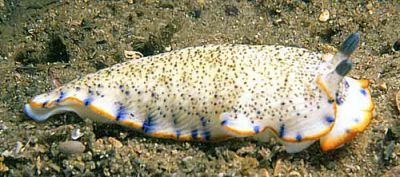
Armina sp. 7
Order: NUDIBRANCHIA
Suborder: ARMININA
Family: Arminidae
PHOTO
Little Beach (between Fly Point and Halifax Park in Port Stephens) at about 5m on a soft rubble and mud bottom at dusk. [New South Wales, Australia] 6-8cm long. Photo: Ron Greer
Authorship detailsRudman, W.B., 2001 (June 26) Armina sp. 7 [In] Sea Slug Forum. Australian Museum, Sydney. Available from http://www.seaslugforum.net/find/armisp7
Related messages
Re: Armina sp. 7 from East Timor
March 4, 2009
From: Brian Mayes
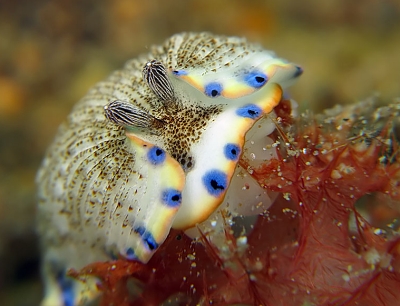
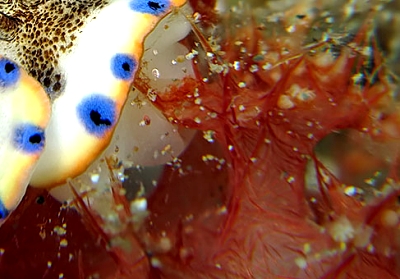
Concerning message #17740:
Dear Bill,
I thought this nudibranch was a Dermatobranchus species, because the mantle behind the rhinophores is incomplete and fused to the head. It's the second time I've come accross it. Firstly in the Perhentians, Malaysia and now in the Philippines. On both occasions it was found feeding on soft coral.
Locality: Secret Bay, Anilao, 17 metres, Luzon, Philippines, Luzon Sea, 14 February 2009, Sandy. Length: 25 mm. Photographer: Brian Mayes.
Best regards
Brian Mayes
brian.r.mayes@gmail.com
Mayes, B.R., 2009 (Mar 4) Re: Armina sp. 7 from East Timor. [Message in] Sea Slug Forum. Australian Museum, Sydney. Available from http://www.seaslugforum.net/find/22300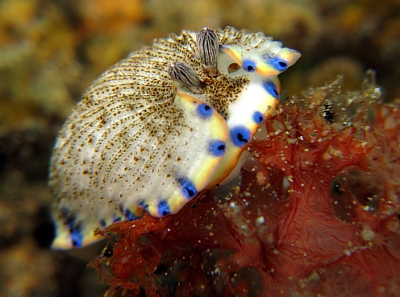
Thanks Brian,
Its a bit hard using external dorsal features to separate the two genera, because some like Armina juliana clearly 'break the rules' and have the mantle fused to the head. One feature which does seem to hold is that in species of Armina there are gills and secondary leaflets on the underside of the mantle which are absent in species of Dermatobranchus. Another 'rule of thumb' is that species of Dermatobranchus are usually small and live on hard substrates or on soft coral colonies while species of Armina are larger and often buried in soft sediments. Unfortunately there are many quite large species of Dermatobranchus to confuse the issue.
Food used to be quite a good character, with species of Armina feeding on pennatulaceans [sea pens] and species of Dermatobranchus feeding on alcyonaceans [soft corals]. Unfortunately Armina cygnea was reported feeding on the alcyonacean Dendronepthya very early in the history of the Forum [message #4] which broke that rule.
I originally placed this species as an Armina because of its size and soft sediment habitat, but as you, and Brian Francisco in an earlier message show [#17740], Armina sp. 7 also feeds on alcyonaceans.
I suspect it is a species of Dermatobranchus, but it might as well stay as it is until someone looks at its anatomy - or even a peek under its mantle skirt to see if it has gills.
Best wishes,
Bill Rudman
Armina sp. 7 from East Timor
November 2, 2006
From: Brian Francisco
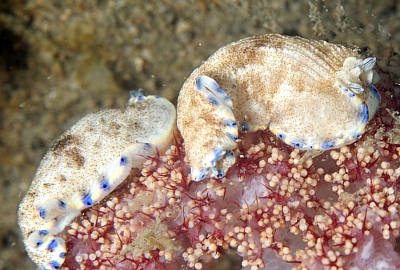
Hi Bill
These nudibranchs appear to be what you call Armina sp. 7. Armina are common on sandy slopes and rubble bottoms in Timor, but usually we see them eating sea pens. In this case, the two Armina were eating a soft coral, Dendronephthya.
Locality: Tasi Tolu, 14 meters, East Timor, Banda Sea, 2 September 2006, Sandy slope. Length: 6-8 cm. Photographer: Brian Francisco.
Thanks
Brian
www.uwet.net
UnderWater East Timor
francisco.brian@gmail.com
Francisco, B., 2006 (Nov 2) Armina sp. 7 from East Timor. [Message in] Sea Slug Forum. Australian Museum, Sydney. Available from http://www.seaslugforum.net/find/17740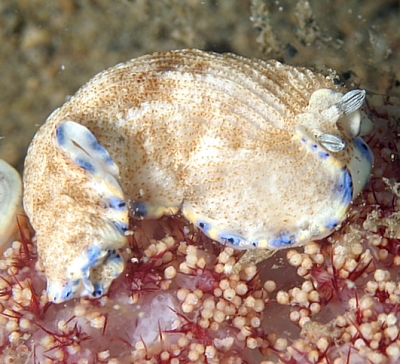
Dear Brian,
Thanks for this observation. We don't know enough about the biology of the arminids to know whether some species are exclusively feeding on sea pens and others on soft corals such as Dendronepthya.
Best wishes,
Bill Rudman
Re: Armina sp. 7
July 4, 2001
From: Ron Greer
Dr. Rudman,
In reference to Armina sp. 7, thanks for your help, its nice to know I didn't miss an obvious identification. I only recorded the year unfortunately - 1995, 'Summer'. I should have been more diligent. It was the only example I saw, and have seen none since.
Regards,
Ron Greer.
diveimage@netspace.net.au
Greer, R., 2001 (Jul 4) Re: Armina sp. 7. [Message in] Sea Slug Forum. Australian Museum, Sydney. Available from http://www.seaslugforum.net/find/4714Dear Ron,
Thanks for any information. It is an interesting find - perhaps a stray and lonely larvae .... and lonely adult when it grew up ... that drifted down to Port Stephens from the tropical north.
Best wishes,
Bill Rudman
Armina from Port Stephens
July 1, 2001
From: Ron Greer

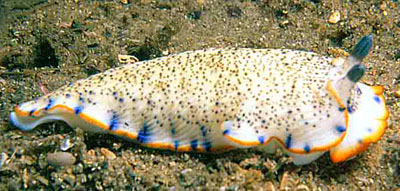
Dr. Rudman,
I found what I suspect is an Armina that I have been unable to ID. I found it at Little Beach (between Fly Point and Halifax Park in Port Stephens) at about 5m on a soft rubble and mud bottom at dusk. [New South Wales, Australia] The animal was about 6-8cm long.
Your assistance in an ID is appreciated.
Ron Greer
diveimage@netspace.net.au
Greer, R., 2001 (Jul 1) Armina from Port Stephens. [Message in] Sea Slug Forum. Australian Museum, Sydney. Available from http://www.seaslugforum.net/find/4673Thanks Ron,
Yes it looks like a species of Armina but not one I am familiar with. Many species have a basic colour pattern of black and white longitudinal lines and it is possibly a species which normally has a thin black line running down each ridge. But even so I don't recognise it. It will be interesting to know if the species has become a regular resident in Port Stephens or whetjer it was a chance settlement of a tropical larva.
Can you give me a rough date please (month & year perhaps?)
bebst wishes,
Bill Rudman
